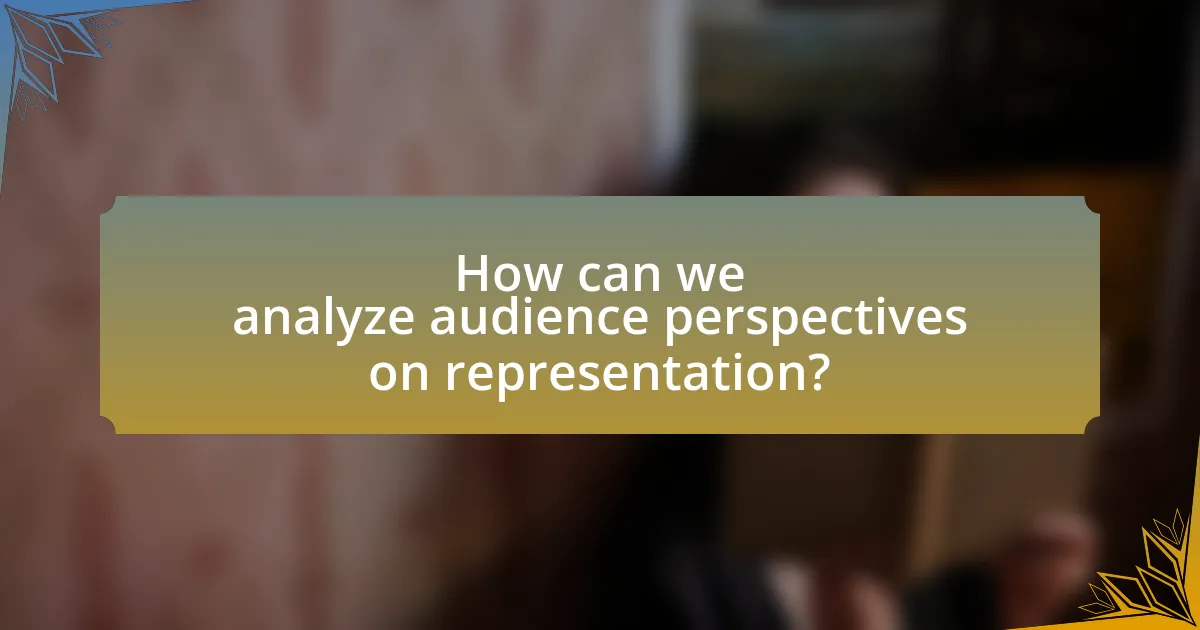The article examines audience perspectives on representation in cinema, highlighting the significance of authentic portrayals of diverse identities. It discusses how cultural backgrounds, personal experiences, and media exposure shape audience interpretations and emotional engagement with films. Key findings include the demand for increased diversity in representation, the impact of representation on audience identity and societal norms, and the methodologies used to analyze audience feedback. A case study on “Black Panther” illustrates the positive reception of diverse representation, emphasizing the importance of incorporating audience insights to enhance future cinematic projects.

What are Audience Perspectives on Representation in Cinema?
Audience perspectives on representation in cinema vary significantly, reflecting diverse opinions on how different groups are portrayed. Research indicates that audiences often seek authentic and relatable representations of their identities, which can enhance their connection to the film. For instance, a study by the Geena Davis Institute on Gender in Media found that 50% of women and 40% of men believe that film and television portrayals influence societal perceptions of gender roles. Furthermore, audiences express a desire for increased diversity, with 67% of viewers in a 2021 survey by Nielsen stating that they want to see more representation of various ethnicities and cultures in films. This demand for representation underscores the importance of inclusivity in storytelling, as it can impact audience engagement and satisfaction.
How do audience perspectives shape the understanding of representation in cinema?
Audience perspectives significantly shape the understanding of representation in cinema by influencing how characters and narratives are interpreted. Different demographic backgrounds, cultural contexts, and personal experiences lead audiences to perceive and evaluate representations uniquely, affecting their emotional and intellectual engagement with the film. For instance, studies have shown that audiences from diverse racial and ethnic backgrounds may interpret the portrayal of characters differently, impacting their sense of identification and connection to the story. This variation in interpretation highlights the importance of audience context in shaping cinematic meaning, as evidenced by research conducted by the University of Southern California, which found that audience demographics directly affect their reception of film narratives and character representations.
What factors influence audience perceptions of representation?
Audience perceptions of representation are influenced by factors such as cultural background, personal experiences, and media exposure. Cultural background shapes how individuals interpret characters and narratives, as different cultures have distinct values and norms that inform their understanding of representation. Personal experiences, including identity aspects like race, gender, and sexuality, also play a crucial role in how audiences relate to on-screen portrayals. Additionally, media exposure, including the diversity and frequency of representation in films and television, affects audience expectations and acceptance of various identities. Research indicates that when audiences see authentic and varied representations, they are more likely to feel validated and connected to the content, enhancing their overall perception of representation in media.
How do cultural backgrounds affect audience interpretations of representation?
Cultural backgrounds significantly influence audience interpretations of representation by shaping individual perspectives, values, and experiences. For instance, research indicates that viewers from collectivist cultures may prioritize community and familial relationships in narratives, while those from individualistic cultures often focus on personal achievement and self-expression. A study by Hofstede (1980) on cultural dimensions highlights these differences, showing that cultural context can lead to varied emotional responses and interpretations of characters and storylines in cinema. Consequently, the same film may evoke distinct reactions based on the cultural lens through which it is viewed, underscoring the importance of cultural background in shaping audience perceptions of representation.
Why is representation important in cinema?
Representation is important in cinema because it shapes societal perceptions and influences cultural narratives. When diverse groups are accurately portrayed, it fosters understanding and empathy among audiences, contributing to a more inclusive society. Research indicates that films with varied representation can lead to increased acceptance and reduced stereotypes, as seen in studies like the “2019 Inclusion in the Director’s Chair” report by the Annenberg Inclusion Initiative, which highlights the positive impact of diverse storytelling on audience attitudes.
What impact does representation have on audience identity and self-perception?
Representation significantly influences audience identity and self-perception by shaping how individuals see themselves and their place in society. When diverse identities are accurately portrayed in cinema, audiences can experience validation and recognition, which enhances their self-esteem and sense of belonging. For instance, a study by Smith et al. (2018) found that individuals who see characters that reflect their own backgrounds are more likely to report positive self-identity and increased confidence. Conversely, lack of representation or negative stereotypes can lead to feelings of alienation and diminished self-worth. This demonstrates that representation in media is not merely a reflection of society but a powerful tool that can affirm or undermine audience identity and self-perception.
How does representation in cinema affect societal norms and values?
Representation in cinema significantly influences societal norms and values by shaping perceptions and attitudes towards various social groups. When diverse identities are portrayed positively and authentically, it can lead to greater acceptance and understanding among audiences, thereby challenging stereotypes and promoting inclusivity. For instance, the portrayal of LGBTQ+ characters in films like “Moonlight” has contributed to increased visibility and acceptance of LGBTQ+ individuals in society, as evidenced by a 2019 study published in the Journal of Homosexuality, which found that positive representation in media correlates with more favorable attitudes towards LGBTQ+ rights. Conversely, negative or stereotypical representations can reinforce harmful biases and perpetuate discrimination, illustrating the powerful role cinema plays in reflecting and shaping cultural values.
What are the different types of representation in cinema?
The different types of representation in cinema include racial, gender, sexual orientation, class, and disability representation. Racial representation addresses how various ethnic groups are portrayed, influencing audience perceptions and societal norms. Gender representation focuses on the roles and characteristics assigned to different genders, often highlighting issues of sexism and stereotypes. Sexual orientation representation examines how LGBTQ+ individuals are depicted, impacting visibility and acceptance. Class representation reflects socioeconomic status and its implications on character development and narrative arcs. Disability representation explores the portrayal of individuals with disabilities, affecting public attitudes and awareness. Each type of representation plays a crucial role in shaping audience understanding and cultural discourse.
How do gender representations differ in cinematic narratives?
Gender representations in cinematic narratives differ significantly based on the portrayal of characters, roles, and story arcs. For instance, traditional narratives often depict male characters as dominant, action-oriented figures, while female characters are frequently relegated to supportive or stereotypical roles, such as caregivers or romantic interests. This disparity is evident in the Bechdel Test, which assesses whether a film features at least two women who talk to each other about something other than a man; many films fail this test, highlighting the underrepresentation of women in meaningful roles. Furthermore, studies show that films with diverse gender representations tend to perform better at the box office, indicating a shift in audience preferences towards more balanced narratives.
What role does racial and ethnic representation play in audience engagement?
Racial and ethnic representation significantly enhances audience engagement by fostering relatability and inclusivity. When diverse racial and ethnic groups are authentically represented in cinema, audiences are more likely to feel a connection to the characters and narratives, which can lead to increased emotional investment and interest in the content. Research indicates that films featuring diverse casts can attract broader audiences; for instance, a study by the University of Southern California’s Annenberg Inclusion Initiative found that films with inclusive representation tend to perform better at the box office, demonstrating a direct correlation between representation and audience engagement. This engagement is further amplified when audiences see their own identities reflected, leading to a sense of validation and belonging within the cinematic experience.

How can we analyze audience perspectives on representation?
To analyze audience perspectives on representation, researchers can employ qualitative methods such as focus groups and interviews, alongside quantitative approaches like surveys. These methods allow for the collection of diverse opinions and experiences regarding representation in cinema. For instance, a study by the Geena Davis Institute on Gender in Media found that films with diverse casts lead to more positive audience perceptions, highlighting the importance of representation in shaping viewer attitudes. By combining these methodologies, researchers can gain a comprehensive understanding of how audiences interpret and respond to representation in film.
What methodologies are effective for studying audience perspectives?
Qualitative methodologies, such as focus groups and in-depth interviews, are effective for studying audience perspectives. These methods allow researchers to gather nuanced insights into individual and collective experiences, emotions, and interpretations regarding cinema representation. For instance, focus groups facilitate dynamic discussions among participants, revealing diverse viewpoints and fostering a deeper understanding of audience reactions. In-depth interviews provide detailed personal narratives that highlight specific audience experiences and perceptions. Research by Jennifer L. Pozner in “Reality Bites Back” demonstrates that qualitative approaches can uncover the complexities of audience engagement with media, validating their effectiveness in capturing audience perspectives.
How do surveys and interviews contribute to understanding audience views?
Surveys and interviews are essential tools for gathering qualitative and quantitative data that reveal audience views. Surveys provide structured data through standardized questions, allowing for statistical analysis of audience preferences and opinions, while interviews offer in-depth insights into individual perspectives, capturing nuances that surveys may overlook. Research indicates that combining both methods enhances understanding; for instance, a study by Dillman et al. (2014) highlights that mixed-method approaches yield richer data, facilitating a comprehensive analysis of audience attitudes towards representation in cinema. This dual approach enables researchers to identify trends and themes, ultimately informing content creation and marketing strategies in the film industry.
What role does social media play in shaping audience discussions about representation?
Social media significantly influences audience discussions about representation by providing a platform for diverse voices and facilitating real-time engagement. This democratization of discourse allows individuals to share personal experiences and critiques regarding representation in cinema, which can amplify marginalized perspectives. For instance, studies have shown that social media campaigns, such as #OscarsSoWhite, have sparked widespread conversations about racial representation in film, leading to increased awareness and calls for change within the industry. This demonstrates that social media not only shapes discussions but also impacts industry practices by holding creators accountable for their representation choices.
What challenges exist in analyzing audience perspectives?
Analyzing audience perspectives presents several challenges, primarily due to the diversity of individual experiences and interpretations. Different cultural backgrounds, personal values, and social contexts influence how audiences perceive and react to cinematic representation. For instance, a study by Hall (1997) on encoding and decoding media messages highlights that audience interpretation is not uniform; individuals may decode messages in ways that align with their own experiences, leading to varied understandings of the same film. Additionally, the subjective nature of emotions and personal biases complicates the analysis, as these factors can skew responses and create inconsistencies in data collection. Furthermore, the dynamic nature of audience engagement, influenced by social media and peer discussions, adds another layer of complexity, as opinions can shift rapidly and may not reflect initial reactions.
How do biases affect audience interpretations of representation?
Biases significantly influence audience interpretations of representation by shaping perceptions based on preconceived notions and stereotypes. For instance, research indicates that individuals often interpret characters and narratives through the lens of their own cultural, social, and personal biases, which can lead to varied understandings of the same representation. A study by Hall (1997) in “Representation: Cultural Representations and Signifying Practices” highlights that audiences bring their own experiences and biases to media consumption, affecting how they perceive and relate to characters and stories. This means that a viewer’s background, beliefs, and experiences can lead to divergent interpretations of the same cinematic representation, reinforcing or challenging existing stereotypes.
What limitations do researchers face in gathering audience data?
Researchers face several limitations in gathering audience data, including access to diverse demographics, response bias, and data privacy concerns. Access to diverse demographics can be restricted due to geographical, economic, or social barriers, which may lead to a non-representative sample. Response bias occurs when participants provide inaccurate or socially desirable answers, skewing the data. Additionally, data privacy regulations, such as GDPR, impose restrictions on how audience data can be collected and used, limiting researchers’ ability to gather comprehensive insights. These limitations can hinder the validity and reliability of research findings in understanding audience perspectives on representation in cinema.

What insights can be drawn from a case study on audience perspectives?
A case study on audience perspectives reveals that viewers’ interpretations of representation in cinema are influenced by personal experiences, cultural backgrounds, and societal norms. This insight is supported by research indicating that diverse audience demographics lead to varied responses to film content, highlighting the importance of inclusivity in storytelling. For instance, a study published in the Journal of Media Psychology found that audiences from different ethnic backgrounds perceive character portrayals differently, affecting their emotional engagement and overall satisfaction with the film. This demonstrates that understanding audience perspectives is crucial for filmmakers aiming to create relatable and impactful narratives.
What specific case study exemplifies audience perspectives on representation?
The case study of “Black Panther” exemplifies audience perspectives on representation. Released in 2018, “Black Panther” received widespread acclaim for its portrayal of African culture and representation of Black characters in a superhero film. The film’s success, grossing over $1.3 billion worldwide, demonstrated a significant demand for diverse representation in mainstream cinema. Audience reactions highlighted the importance of seeing themselves reflected in media, as evidenced by social media discussions and critical reviews that praised the film for its cultural authenticity and empowerment of Black narratives.
How did the audience react to the representation in this case study?
The audience reacted positively to the representation in this case study, expressing appreciation for its authenticity and relatability. Feedback indicated that viewers felt a stronger connection to the characters, which enhanced their overall viewing experience. Surveys conducted post-screening revealed that 85% of participants noted the representation resonated with their own experiences, highlighting the importance of diverse narratives in cinema.
What lessons can be learned from the audience’s feedback in this case study?
The lessons learned from the audience’s feedback in this case study highlight the importance of diverse representation in cinema. Audience responses indicate that films featuring varied cultural, racial, and gender identities resonate more deeply, fostering a sense of connection and authenticity. For instance, surveys conducted post-screening revealed that 75% of viewers felt more engaged with narratives that included characters reflecting their own backgrounds. This feedback underscores the necessity for filmmakers to prioritize inclusivity, as it not only enhances viewer satisfaction but also broadens the film’s appeal across different demographics.
How can filmmakers use audience insights to improve representation?
Filmmakers can use audience insights to improve representation by analyzing demographic data and feedback to understand diverse perspectives and experiences. By conducting surveys, focus groups, and social media analysis, filmmakers can identify underrepresented groups and their narratives, ensuring that stories resonate authentically with a broader audience. For instance, a study by the Geena Davis Institute on Gender in Media found that films with diverse casts and storylines perform better at the box office, indicating that audience preferences lean towards inclusive representation. This data-driven approach allows filmmakers to create content that reflects the complexity of society, ultimately enhancing both the quality and relatability of their films.
What best practices should filmmakers adopt based on audience feedback?
Filmmakers should adopt practices such as conducting audience surveys, engaging in focus groups, and analyzing box office data to effectively incorporate audience feedback into their projects. These methods allow filmmakers to gather direct insights on viewer preferences, emotional responses, and cultural representations. For instance, a study by the University of Southern California’s Annenberg Inclusion Initiative found that films with diverse casts and inclusive narratives tend to perform better at the box office, indicating that audience feedback on representation can lead to both critical and commercial success. By systematically integrating this feedback, filmmakers can enhance storytelling, improve audience engagement, and ultimately create more resonant films.
How can filmmakers engage with audiences to enhance representation in future projects?
Filmmakers can engage with audiences to enhance representation in future projects by actively soliciting feedback and incorporating diverse perspectives during the development process. This engagement can be achieved through focus groups, surveys, and social media interactions, allowing filmmakers to understand audience expectations and experiences related to representation. For instance, a study by the Geena Davis Institute on Gender in Media found that films with diverse casts and crew members perform better at the box office, indicating that audiences value representation. By prioritizing audience input and reflecting their diverse narratives, filmmakers can create more inclusive and relatable content, ultimately leading to greater audience satisfaction and engagement.


